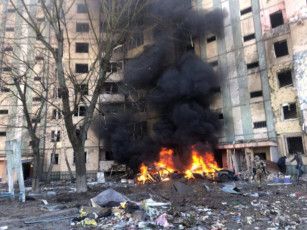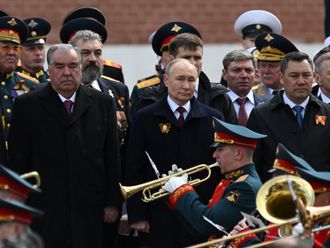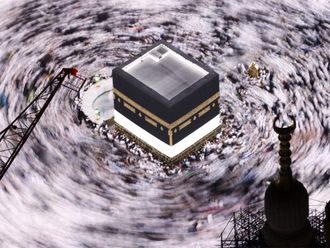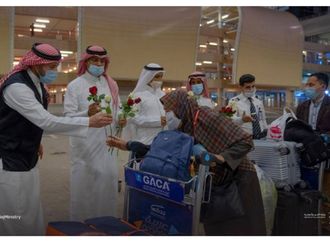
Lviv: Ukrainian authorities said Sunday that Russia’s military bombed an art school sheltering some 400 people in the port city of Mariupol, where heavy street fighting is underway weeks into a devastating Russian siege.
The fall of Mariupol would allow Russian forces across southern and eastern Ukraine to link up. But Western military analysts say that even if the surrounded city is taken, the troops battling for control there a block at a time may be too depleted to help secure Russian breakthroughs on other fronts.
Three weeks into the conflict, Western governments and analysts see it shifting to a war of attrition, with bogged down Russian forces launching long-range missiles at cities and military bases as Ukrainian forces carry out hit-and-run attacks and seek to sever their supply lines.
There was no immediate word on casualties from the reported strike on the art school. City officials and aid groups have described dire conditions in Mariupol, where food, water and electricity have run low and the fighting has prevented humanitarian convoys from reaching the city. Communication lines in Mariupol have been severed, making it difficult to verify reports from the city.
The strategic port on the Azov Sea has been under bombardment for over three weeks and has seen some of the worst horrors of the conflict in Ukraine. At least 2,300 people have died, some of whom had to be buried in mass graves, city officials have said.
In recent days, Russian forces have battled their way into Mariupol, cutting it off from the Azov Sea and devastating a massive steel plant. But the city’s fall could prove a costly victory.
“The block-by-block fighting in Mariupol itself is costing the Russian military time, initiative, and combat power,” the Washington-based Institute for the Study of War said in a briefing.
In major cities across Ukraine, hundreds of men, women and children have already been killed, while millions have raced to underground shelters or fled the country.
In the capital, Kyiv, at least 20 babies carried by Ukrainian surrogate mothers are stuck in a makeshift bomb shelter, waiting for parents to travel into the war zone to pick them up. The infants _ some just days old _ are being cared for by nurses who cannot leave the shelter because of constant shelling by Russian troops who are trying to encircle the city.
In the hard-hit northeastern city of Sumy, authorities evacuated 71 orphaned babies through a humanitarian corridor, regional governor Dmytro Zhyvytskyy said Sunday. He said the orphans, most of whom need constant medical attention, would be taken to an unspecified foreign country.
Russian shelling killed at least five civilians, including a 9-year-old boy, in Kharkiv, an eastern city that is Ukraine’s second-largest.
The British Defence Ministry said Russia’s failure to gain control of the skies over Ukraine “has significantly blunted their operational progress,” forcing them to rely on stand-off weapons launched from the relative safety of Russian airspace.
A rocket attack on the Black Sea port city of Mykolaiv early Friday killed as many as 40 marines, a Ukrainian military official told The New York Times, making it one of the deadliest single attacks on Ukrainian forces.
In a separate strike, the Russian Defence Ministry said a Kinzhal hypersonic missile hit a Ukrainian fuel depot in Kostiantynivka, a city near Mykolaiv. The Russian military said Saturday that it used a Kinzhal for the first time in combat to destroy an ammunition depot in the Carpathian Mountains in western Ukraine.
Russia has said the Kinzhal, carried by MiG-31 fighter jets, has a range of up to 2,000 kilometers and flies at 10 times the speed of sound. The Pentagon says it has not yet confirmed the use of a hypersonic missile in Ukraine.
Konashenkov said Kalibr cruise missiles launched by Russian warships from the Caspian Sea were also involved in the strike on the fuel depot in Kostiantynivka and were used to destroy an armor repair plant in northern Ukraine.
Western analysts have downplayed the significance of Russia’s use of the hypersonic weapon, saying the missiles did not give Moscow an extra advantage but were a tool the Kremlin could use to advertise its military might and warn other countries against intervening.
“It’s not a game-changer,” but rather a “message of intimidation and deterrence towards Ukraine and towards the West,” said Valeriy Akimenko, senior research associate at the Conflict Studies Research Centre in England.
UN bodies have confirmed more than 847 civilian deaths since the conflict began, though they concede the actual toll is likely much higher. The UN says nearly 3.4 million people have fled Ukraine as refugees.
Estimates of Russian deaths vary widely, but even conservative figures are in the low thousands. Ukrainian authorities have reported that six Russian generals have died during the war. The Russian military hasn’t confirmed the deaths of any of them. The death of one general was confirmed by his associate and an officers’ group in Russia.
Ukraine and Russia have held several rounds of negotiations aimed at ending the conflict, but the neighboring countries remain divided over several issues. Zelenskyy has said he is willing to drop Ukraine’s bid to join NATO but wants certain security guarantees from Russia. Moscow is pressing for Ukraine’s complete demilitarisation.
Mariupol authorities said Sunday that nearly 40,000 people had left the city in the last week, the vast majority in their own vehicles, despite ongoing air and artillery strikes. That alone amounts to nearly 10 per cent of the city’s prewar population of 430,000.
Russia-backed separatists in eastern Ukraine said Sunday that 2,973 people have been evacuated from Mariupol since March 5, including 541 over the last 24 hours.












